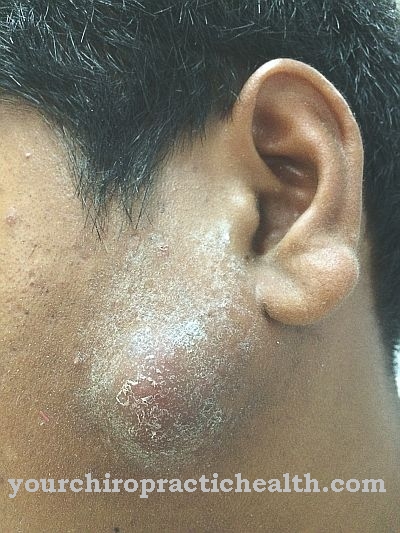The following text provides information about Wounds, their causes, their diagnosis and the following course, about their further treatment and preventive measures.
What is a wound?

A wound is generally described as a superficial injury to the skin (medical: tissue destruction or severing). The injury can result in tissue loss. If the wound was caused by psychological damage, it is called a traumatic wound.
Due to the variety of different wounds, they can be classified according to type or cause. There are the following types of wounds:
Mechanical wounds: are caused by force or force. Mechanical wounds include B. abrasions, cuts, lacerations, gunshot wounds, bite wounds or bruises.
Thermal wounds: caused by burns, scalds or frostbite of the tissue.
Chemical wounds: are caused by the effects of acid, alkali or poison and cause burns.
Radiation wounds: are damage caused by X-rays or radioactive radiation.
causes
Cause of the most common Wounds are external violence or diseases.
Wounds caused by external violence are:
- Accidental wounds that are caused by chance.
- Surgical and laser wounds that are necessary and unavoidable.
- Intentional violent wounds, e.g. B by cutting or firearms.
- Burn or scald wounds.
- Wounds caused by rough or pointed surfaces and objects.
Disease wounds are:
- Wounds caused by circulatory disorders (injuries no longer heal).
- Wounds caused by sensory disturbances or insensitivity to pain.
- Wounds caused by paralysis.
Diseases with this symptom
- Laceration
- Bite wound
- Hypothermia
- Leg Ulcer
- Abrasion
- Bruises
- Chemical burn
- Blood poisoning
- Cut
- combustion
- Circulatory disorders
- Wound healing disorders
Diagnosis & course
Diagnosis and course of wound depend on how big and severe it is and whether there is an infection. A wound can be recognized by the following symptoms: redness, pain, warmth, swelling and, as a result, functional impairments.
If the wound is smaller and not infected, it does not need to be treated. Healing can be expected in 6-8 days. If the wound turns blue or there is throbbing pain and a red stripe (blood poisoning), a doctor should be consulted.
If the wound is larger and also soiled, infected, bleeding heavily or contains foreign bodies, the wound must be treated by a doctor. Most often, such wounds are animal bites, lacerations. Burns or contusions.
Complications
A wound can have a wide variety of complications, depending on where the wound is on the body. For example, if it is an open flesh wound, such an injury must always be kept clean. Otherwise complications such as severe inflammation and the formation of pus can occur.
Even with medical care, various complications and undesirable healing processes can occur. If there is a bleeding disorder, the wound heals very poorly and bleeding occurs repeatedly. In such a case, it is imperative to take appropriate medication.
If there is a wound or an injury to the head, complications such as concussions, nausea or a strong feeling of dizziness can arise. If the head is shaken, there is also the risk of cerebral haemorrhage, which can lead to death. In the said cases, medical advice must of course be sought, otherwise there is a risk of serious consequential damage.
Only those who keep a wound clean and pure can prevent possible complications. Any inflammation that occurs can be treated with medication such as antibiotics. Frequently occurring complications can thus be prevented or treated effectively.
When should you go to the doctor?
A wound is not an independent clinical picture. It is usually achieved by external force. According to this, a wound can exist in different degrees of severity, so that direct medical treatment is not always necessary. Deep flesh wounds are one of the types that definitely require medical and drug treatment. This is because flesh wounds cannot grow together on their own.
However, if you forego treatment by a doctor in such a case, you are putting yourself at great risk. If a wound does not grow together, bacteria and viruses can lodge in it. Inflammation may then develop, which can lead to further complications. It is not uncommon for this to result in an accumulation of pus, which of course also urgently requires medical care. If a corresponding treatment is not taken at this point, there is even a risk of dangerous blood poisoning.
So the following applies: In the case of deep wounds, a doctor should be consulted immediately. In this way, inflammation and other complications can be avoided at an early stage. Smaller wounds should heal completely by themselves, provided there is no bleeding disorder. Treatment by a doctor or medication is not necessary.
Doctors & therapists in your area
Treatment & Therapy
Smaller ones Wounds should first bleed out during treatment, then be cleaned with disinfectant and then bandaged with a sterile bandage that is changed every 2-3 days. If a larger wound is to be treated, the wound must first be disinfected and, if necessary, foreign bodies removed, the wound should be X-rayed or treated with antibiotics and possibly sewed up promptly.
The wound should be kept calm during the healing phase. There are 4 phases in the treatment and optimal healing of the wounds:
Phase 1: The typical symptoms (redness, pain, swelling and warmth) appear in days 1-3.
Phase 2: In days 4-7, the skin is slowly restored through so-called wound margins.
Phase 3: In days 8-12, connective tissue fibers form, which strengthen the skin again. The edges of the wound grow together.
Phase 4: From the 2-3 week the skin is resilient as before. The larger the wound, the longer this can take.
If complications arise from treating the wound, it will take longer to heal. Causes of complications are e.g. B. Infections caused by soiling of the wound, existing blood diseases or diabetes.
Outlook & forecast
It is very difficult to predict the course of the disease or the healing process of a wound, since a wound can appear in various degrees of severity. A simple injury to the top layers of the skin is absolutely not a worrying clinical picture, which must be examined or treated by a doctor. Even without the appropriate medication, healing is likely to take place more quickly.
Nevertheless, the affected person should make sure that the wound remains protected from contamination. Otherwise, an infection can develop very quickly and cause inflammation. If such an inflammation remains without any medical or drug care, there is a risk of blood poisoning. If you do not want to take this risk, you should always have an inflammation treated by a doctor. With appropriate care, the prognosis of complete healing within a short time looks very good.
If a wound is very deep, it may even have to be sutured. A stitched wound usually heals completely within four to six weeks. However, if you forego appropriate treatment at this point, you must expect considerable complications and a significantly longer healing time in such a case. As a general rule, wounds of all kinds should be kept clean and pure. This is the only way to guarantee a quick and smooth healing process.
prevention
Around Wounds To prevent this, pay special attention to your surroundings and avoid possible sources of danger. This particularly includes accidents. However, since wounds appear very quickly, care must be taken when self-treating that no fatty products get into the wound.
These prevent healing and can cause infection. Greasy ointments may only be used to make the edges of the wound crust more supple. In the case of minor burn wounds, the use of cod liver oil is recommended for prevention. Superficial wounds can be treated with chamomile flowers / marigold tinctures.
You can do that yourself
A few home remedies and tricks can help with the initial treatment of a wound. Smaller wounds should first be rinsed out under cold water to avoid inflammation. Cuts can be stopped by placing a sterilized, hot cloth over the wound. The acute bleeding can be stopped by lifting the injured part of the body.
If the bleeding is profuse, a pressure bandage should be applied and the wound should be kept calm. However, the wound must not be bandaged too tightly, as the skin needs fresh air in the healing process. Schnapps or another high-percentage alcohol can also be used to disinfect the wound. You can also use poultices with honey or aloe vera. To reduce scarring, the wound can then be rubbed daily with St. John's wort oil. If possible, the scab should be protected with a plaster until it falls off on its own. If the wound heals poorly, Peru balsam can be applied from the pharmacy.
Chamomile tea, real thyme and marigold ointment also have a healing effect. You should also drink plenty of water. Foods with many vitamins and proteins support the formation of skin cells and thus accelerate the healing process. Larger wounds that are severely painful or bleeding should be treated promptly by a doctor.



























